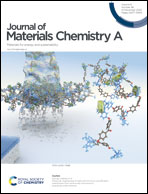Cu–Fe–NH2 based metal–organic framework nanosheets via drop-casting for highly efficient oxygen evolution catalysts durable at ultrahigh currents†
Abstract
Synthesizing binder-free metal–organic frameworks (MOF) as thin films on a large scale to serve directly as electrodes for water electrolysis is challenging. Here, we report a simple and readily scalable strategy for fabricating binder-free Cu–Fe–NH2 based MOF thin film-electrodes directly applicable as a catalyst for water electrolysis. Films composed of thin 2D-nanosheets of the MOF were deposited by dropping ink obtained from solvothermally synthesised bulk MOFs onto nickel foam substrates, or simply immersing the substrates in the ink. The Cu–Fe–NH2 MOF electrodes demonstrated excellent oxygen evolution reaction (OER) performance, comparable or superior to recently reported state-of-the-art MOFs. Strikingly, the MOF electrodes exhibited a remarkably low OER overpotential of 330 mV at a high current density of 500 mA cm−2, and excellent durability with a very minor chronopotentiometric decay loss of 1.26% at the end of a 24 h test at a high bias current of 500 mA cm−2.



 Please wait while we load your content...
Please wait while we load your content...